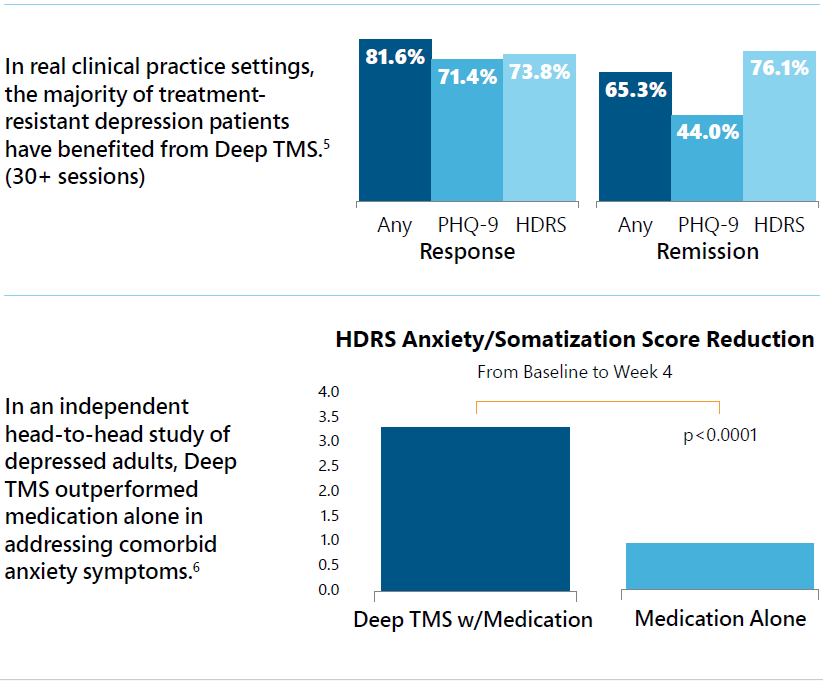
How does TMS work?
During a TMS session, an electromagnetic coil is placed on the scalp, typically near the forehead. The device generates magnetic pulses that pass through the skull and stimulate the underlying neurons in specific regions of the brain. The stimulation helps rebalance brain activity, particularly in areas associated with mood regulation and cognitive function.
Deep TMS: H1 Coil for Major Depressive Disorder (MDD)
Each session typically takes 20 minutes involving stimulation of brain targets with Deep TMS. The treatment coil delivers gentle electromagnetic pulses to key areas in your brain involved in mood regulation. These pulses feel like mild tapping on your scalp. You’ll be comfortably sitting in a chair, awake and alert during the treatment.
Advantages of TMS Over Traditional Treatments:
No Need for Medication: TMS offers a non-pharmacologic alternative to those who want to avoid the side effects of medications. After a successful treatment, talk to your provider about a plan to reduce or remove your medications.
Outpatient Procedure: TMS is a non-invasive outpatient procedure, so it does not require hospitalization or anesthesia. Most patients experience little to no downtime and can resume their normal activities immediately after the session.
TMS therapy for Depression
If you have tried at least two different medications for depression with little to no effect, and you are still experiencing depressive symptoms, there is a good chance that we can work with your insurance plan to approve TMS treatment.
Patients with severe depression symptoms do not always respond sufficiently to psychotherapy or pharmacotherapy.
• Recurrent depression episodes, as well as negative expectations about depression treatment, have been shown to be associated with reduced outcomes for psychotherapy.1, 2
• As shown in the STAR*D study, 63% of depressed patients fail to achieve remission with first-line medication. 33% fail to achieve remission from any medication treatment.3 Patients often discontinue medication due to serious side effects.
• Antidepressant medication frequently produces debilitating side effects, such as weight gain, sexual dysfunction, suicidal thoughts, nausea, insomnia, and anxiety.
What to Expect During the
The TMS process
Consultation
During your initial consultation, our providers will discuss your medical history and determine whether TMS is right for you. This is when a thorough and personalized assessment will take place.
Mapping
Next, we will have a mapping session where we will locate the areas of your brain that we will target for stimulation. During this mapping session, we will develop a personal treatment plan tailored to your unique needs.
Sessions
After this, your consecutive TMS sessions will begin. It is important to continue treatments regularly for up to 36 sessions, without interruption. Sessions will typically last for 15-20 minutes, or, if using our Theraburst technology, 5-10.
Deep TMS - What is the difference?
BrainsWay Deep TMS is a noninvasive, FDA-cleared, outpatient brain stimulation procedure with proven clinical results for improving symptoms of depression (including depression with comorbid anxiety).
The technology stimulates neuronal targets using its patented H-Coil, resulting in a deep and broad penetration of the magnetic field into areas of the brain that are affected in neuropsychiatric disorders.
Covered by most insurers for depression, Deep TMS is safe and well-tolerated, has no systemic side effects, and does not require anesthesia.
How Effective is Deep TMS in Treating Depression and Anxious Depression?
Safety and efficacy of BrainsWay’s Deep TMS H1 Coil in alleviating depression symptoms has repeatedly been demonstrated in multiple clinical studies and real clinical usage.
Deeper & Broader Stimulation, Activating More Neurons
What Happens During Deep TMS Treatment?
With all forms of TMS, the intensity of stimulation naturally decays as it reaches deeper into the brain. Our unique coil design allows for the strength of stimulation to be maintained at effective levels even in regions deeper within the brain that are affiliated with the indications we treat.
For patients that are older, traditional TMS may not penetrate deep enough to generate a therapeutic effect, as in the case of late-life depression.
Each 20-minute session involves stimulation of brain targets with Deep TMS. The treatment coil delivers gentle electromagnetic pulses to key areas in the brain involved in mood regulation. These pulses feel like mild tapping on the scalp.
The patient will be sitting comfortably in a chair, awake and alert during the treatment.













